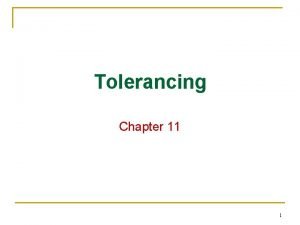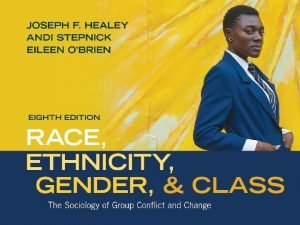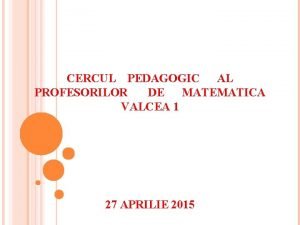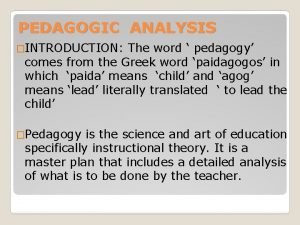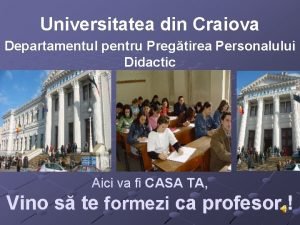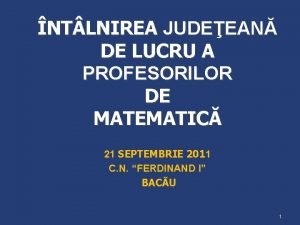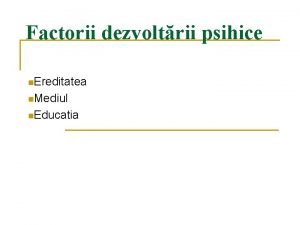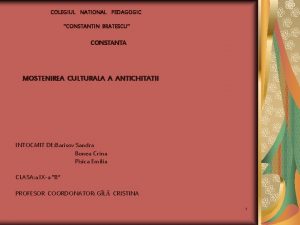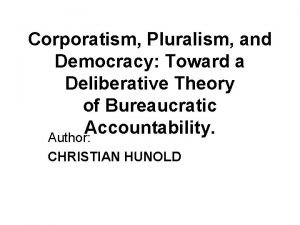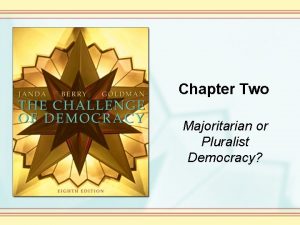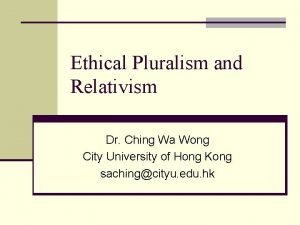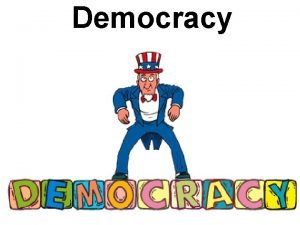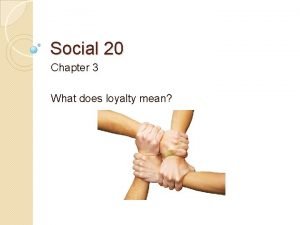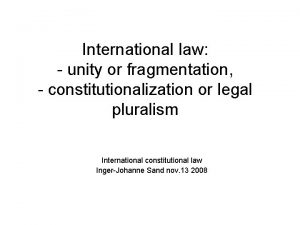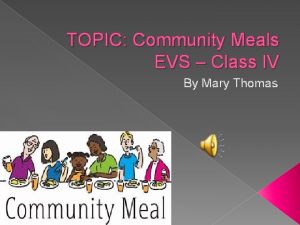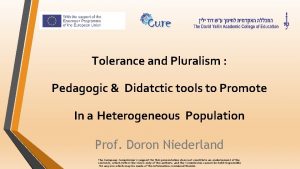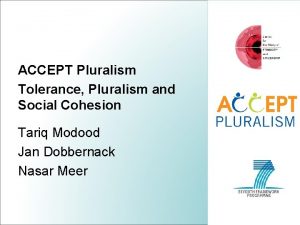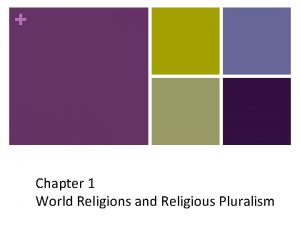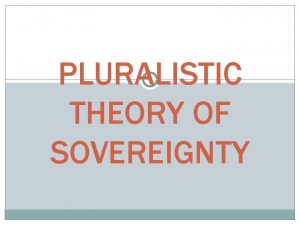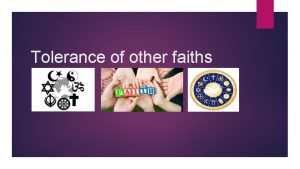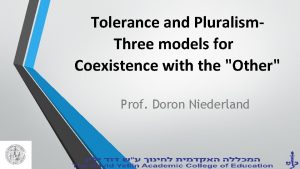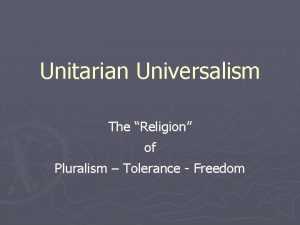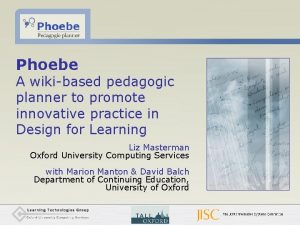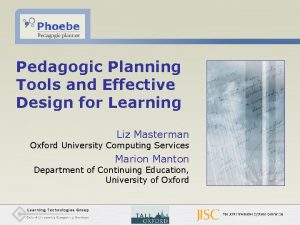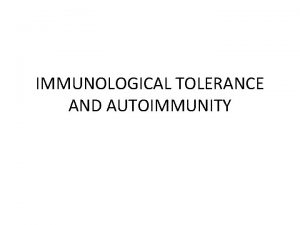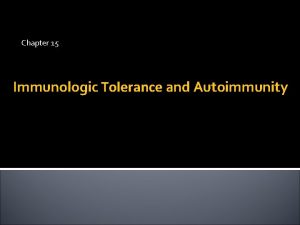Tolerance and Pluralism Pedagogic Didatctic tools to Promote

























- Slides: 25

Tolerance and Pluralism : Pedagogic & Didatctic tools to Promote In a Heterogeneous Population Prof. Doron Niederland

Tolerance and Pluralism : Pedagogic & Didatctic tools to Promote In a Heterogeneous Population v. The Reichman Modelq. Dillema Based Model v. The Imago Modelq analysing antagonistic texts

The Educational Goal of the Models The aim of the two models is to provide students with tools to form their own narrative, while familiarizing themselves with alternate narratives of their classmates. They develop tolerance and pluralism in general, and within the College, in particular.

The Educational Goal of the Models • The two models promote communication and discourse between people with different opinions and ways of life. • The models use analysis of conflicting values dilemmas and collaborative learning of antagonistic texts representing different perceptions.

The Roxana Reichman model David Yellin College This model has been implemented in the course: Education towards Morals and Values. The lessons were on “Conflicting Values and Rights” in a democratic society.

The Roxana Reichman model The dilemmas • Demonstrations held in front of the house of the Legal Advisor to the Government. • Blocking of Bar-Ilan Street during weekends and holidays.

Feedback questionnaires’ findings Quantitative Findings • Agreement ("Agree" or "Strongly agree") was in high percentage with statements concerning character of tasks, the interest in the studied material, the lecturer's promotion of active participation and the lecturer's will to answer questions. • • However, statements relating to courses innovativeness and challenge were less agreed. 92 to 94% of the respondents agreed with statements regarding the connection between the course and development civil responsibility, the course's structure and organization, the interest in the course's subjects, the clarity of the course's objectives. • Highest score was given to satisfaction from the lecturer and the learning subject.

Quantitative Findings- Reichman Model • However, in the assertion of the course as innovative, less than two thirds of the respondents agreed and only 43. 7% agreed to the assertion regarding the challenging nature of the course. .

Quantitative Findings- Reichman Model • In the overall evaluation of the course's quality, two thirds ranked it highest ("very good" or "excellent") and another quarter ranked it as "good. " • 41. 2% ranked the course as easy and 52. 9% as intermediate. • All the students would recommend the course to others, .

Qualitative Findings- Reichman Model The courses strengths and weaknesses: • Strength: Lecturer - accessible and interesting, patient and tolerant, giving everyone a respectful place, attentive, good and orderly guidance, theoretical knowledge was taught as a base for experiencing • The model - development of different viewpoints , critical and creative discourse, out-of-the-box thought, mutual listening , provision of tools to teach controversial topics and objective examination of dilemmas from multiples viewpoints.

Qualitative Findings- Reichman Model The courses strengths and weaknesses • collabative learning – all the students take an active part in class, Enriching discussions • Weaknessdilemmas that are even further complex should be discussed, such as Arab-Jewish relations

Qualitative Findings- Reichman Model Course characteristics allowing change of attitudes • • Examination of an issue from different angles allows keeping an open mind, • Reference to conflicting rights focused the thought about dilemmas in everyday life, Comparison the opinion upon introduction to the one ensuing the “De Bono Hat" test enables updating positions, • I learned to analyze a dilemma using new tools, • The “De Bono Hat" model offers an inclusive and diversified view of dilemmas, • The model allows a view of every alternative's pros and cons, • I saw others change positions • Perspective is broadened,

The Imago Model A qualitative and quantitative analysis of the Imago method carried out in the “Education towards Morals and Values” course.

The Imago Model • In all the assertions, excluding those of learning innovative and challenging material, agreement ("Agree" or "Strongly agree") was in high percentage. 100% of the respondents stressed the interesting topics and the lecturer promoting active participation. • “The course as innovative and challenging” • less than two thirds of the respondents agreed with the first one and only 55. 6% agreed to the second statement.

The Imago Model • 16 of the 18 respondents gave the course a high rank ( "very good" or "excellent). • Two thirds ranked it as intermediate. A sixth ranked it easy and another sixth said it was hard. • Regarding recommendation to others, 17 out of the 18 respondents would do so.

• The Imago Model The courses strengths and weaknesses: • • • It encourages participation and is interesting discourse is inclusive and stirs up thinking students tend to cooperate within the course it provides accurate tools for proper teaching of conflicts the methods are interesting it is relevant it teaches one to deal with the different other it opens the viewpoint of the student learns to listen to the other and “to count to ten” before addressing dilemmas the lecturer was cordial, empathic, tolerant and patient, leading to the same behavior of students • explanations were coherent.

The Imago Model The course's influence on the capability to change opinions: • I listened to my classmates' opinions • I tried to stand in their shoes • I accepted multiple opinions of others • I tried to see things even I disagree with • The course promoted critical thinking • Bringing up other points of view • I was happy to hear other opinions of people I am not familiar with.

The Imago Model • • I was given practical tools to use in my personal life, The Imago model helps change the attitude towards opinions of "others", I worked with ideas opposing mine without losing my own personal position, The method disassembles the reaction process, Helps using my head to thinking and not my gut, Producing a more subtle and less vehement reaction, It gave me a better capability to listen and reflect things in my response, The lecturer's intellectual flexibility helped various opinions to be heard.

In-service teachers from Holon and civics teacher trainers Two workshops were performed on the Imago and Reichmann models for in-service teachers teaching civics. The feedback refers to both models

In-service teachers from Holon and civics teacher trainers • 84% of the Holon teachers ranked the course high (very good or excellent), while 64% of the civics trainers ranked it so. • In both groups - low rates of agreement regarding the course's innovativeness and challenge - 36% and 44%, respectively

In-service teachers from Holon and civics teacher trainers • structured and organized course, • interesting course and learning materials, • clear course objectives, • active participation , • the lecturer answers questions – some assertions even reached 100% agreement. • Course's difficulty level -More than half of the respondents assessed the as intermediate. • Almost All will recommend the course to their colleagues •

Qualitative Feedback : In-service civics teacher trainers & Holon Teachers. • Civics teacher trainers emphasized the importance of working in groups, activation of learners and model implementation in practice. Practice led to internalization. They noted the clear way things were presented pointed out the need for longer workshops. • The teachers from Holon noted that the models were practical and accessible tools, encouraging the learners' participation, discourse and discussion as well as understanding and interest.

Qualitative Feedback : In-service civics teacher trainers & Holon Teachers. • The models are relevant and applicable to creative, • Refreshing and interesting teaching. • They develop thought, • Add viewpoints and lead to presentation of attitudes based on • • • theoretical knowledge and emotions. The discourse presented opposing opinions. The models stimulate empathy and critical thought on social issues. The trainees emphasized the need to discuss also the models' week elements and more practice of model implementation.

summary • Analysis of the feedback forms indicates to the high praise given to the method of implementing the models and the lecturer's conduct. • However, students and in-service teachers as well have a feeling that learning by these methods is neither new nor challenging. • This can be understood as praise - the models are easy for comprehension and application and were explained well, hence they are not challenging. The very positive answers to all the qualitative questions support this interpretation.

summary . Another possible explanation is that active, collaborative and experiential learning that is not overloaded with content is still perceived as neither serious, nor challenging as traditional academic learning by way of an all-knowing professor lecturing in front of the class.
 40h6 tolerance
40h6 tolerance Cellular and molecular immunology
Cellular and molecular immunology Pluralism and absenteeism
Pluralism and absenteeism Pluralism and assimilation
Pluralism and assimilation Cerc pedagogic valcea
Cerc pedagogic valcea Conclusion of pedagogical analysis
Conclusion of pedagogical analysis Modul psihopedagogic craiova
Modul psihopedagogic craiova Proces verbal cerc pedagogic
Proces verbal cerc pedagogic Optimismul pedagogic
Optimismul pedagogic Liceul pedagogic constanta
Liceul pedagogic constanta Pluralism vs corporatism
Pluralism vs corporatism Majoritarianism vs pluralism
Majoritarianism vs pluralism Ethical relativism
Ethical relativism Example of a republican form of government
Example of a republican form of government What is cultural pluralism
What is cultural pluralism Diluted gospel
Diluted gospel Defination of international law
Defination of international law Implement tasks that promote reasoning and problem solving
Implement tasks that promote reasoning and problem solving What is community eating
What is community eating What is fcclas tagline
What is fcclas tagline Fccla mission
Fccla mission Protect, promote, and improve the health of all people
Protect, promote, and improve the health of all people Mr bolanos
Mr bolanos Promoting services and educating customers
Promoting services and educating customers Active learning strategies to promote critical thinking
Active learning strategies to promote critical thinking How to advertise bookkeeping services
How to advertise bookkeeping services
